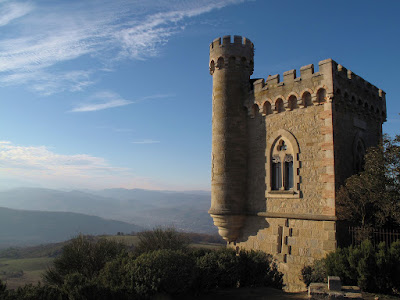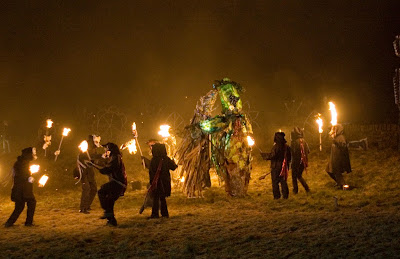An Ancient Mystery in Southern France
Written by Mike H
One of the greatest mysteries in modern times can be found in southern France. In the 19th century, a poor priest becomes rich overnight and builds impressive and beautiful constructions to show his devotion to Mary Magdalene, whom the Catholic Church has refused to see as a saint.
 |
| Magdala Tower, Rennes-le-Château |
The small village of Rennes-le-Château has been at the centre of various legends, myths and conspiracy theories for being the location of an alleged buried treasure discovered by its priest Beranger Saunière in the old town’s church, a secret that his housekeeper and confident, Marie Dénarnaud would also take to the grave. Journalists around the world and various researchers follow one another in an attempt to unveil the mystery surrounding the priest and his unknown source of wealth. What did he really discover during the church renovation? Rumours said that he stumbled across a scroll containing a secret that the Catholic Church has been trying to hide for centuries. Recent conspiracy theories from the seventies claim that the Freemasons would have been the protectors of such a secret!
Having recently viewed some of my photographs from a trip to France in 2012, it came to my mind to explore more about this mysterious village. Plus, having had the chance to read the thriller “Apocalypse” from French authors Eric Giacometti and Jacques Ravenne, it gave me excellent source material in developing this post.
About the Apocalypse Thriller
What is the connection between “Apocalypse” and Rennes-le-Château? Eric Giacometti, Journalist, and Jacques Ravenne, a high-degree Freemason and literary critic, transformed a life-long friendship into a bestselling creative adventure with their Antoine Marcas thriller series. This French freemason police detective is the hero in Apocalypse.
This electrifying thriller combines Freemasonry, the enigmatic drawing “The Shepherds of Arcadia”, multiple assassinations and the struggle of secret societies trying to localize a millenary secret which can alter the course of history forever. In this journey, Marcas is taken from Paris to Jerusalem and finally to Rennes-le-Château.
Rennes-le-Château
What can we find today in Rennes-le-Château? If you ever have the chance to read this book, you will be amazed at similarities that the authors have described, almost like walking into the book itself! First we have the Saint Mary Magdalene Church in the centre of the village. This building is the core of all the mysteries and legends in the novel as the authors compare most of its elements to a Freemason temple.
Above the front door we can find an inscription in Latin reading "this is God's house, the gate of heaven, and it shall be called the royal court of God." Entering the church, a very unusual holy water font grabs our attention. A devil-shaped figure is holding the whole font. The top features four angels making the sign of the cross. The authors claim that the devil is Asmodeus (the guardian of the treasure in Solomon’s temple) and would represent in reality the gatekeeper controlling the access to the Freemasons “séances”. Inside, the floor displays sixty-four white and black square tiles oriented towards the four cardinal points, which resembles a chessboard. The altar of the church displays a Mary Magdalene bas-relief where she is praying inside a cave with a book and skull lying next to her, which according to the authors, corresponds to a Freemason reflection room. There are many more elements to be seen and to discover inside the church, though, I will leave it up to you explore the mystery for yourselves.
 |
| Asmodeus |
In addition to the Church, the priest Beranger Saunière funded and built the Magdala Tower, originally named the Clock Tower, on the edge of the village which he used as his library. This a beautiful building featuring a circular turret with twelve crenellations, situated on a belvedere that connected it to an orangery, a tower-like structure. The tower has a promenade linking it to the Villa Bethania, which was not actually used by the priest. Again, one of the mysteries is how was he able to fund such an expensive construction without the direct support of the Church?
Next to Magdala Tower, stands the Villa Bethania. Its interior is recorded to be decorated with religious symbolism including a stained glass windows depicting the Sacred Heart. Saunière claimed he intended to use it as a home for retired priests, although this is still unclear. Following Saunière’s death in 1917, Marie Dénarnaud, his loyal housekeeper, received permission from the local commune to continue living in the Presbytery and she moved to Villa Bethania until her last days. Today, the whole village has become a museum and it is possible to visit all these three structures by paying a small fee.
 |
| Mary Magdalene bas-relief |
Dear readers, my message for you after this live experience is how a well-researched book can excite our imaginations. Definitely, this factual thriller, based on factual people and events has a positive influence on me. It drove me to visit Rennes-le-Château, even without the need of carrying out any previous research on the Internet. The pull was simply that magnetic. As I entered Saint Mary Magdalene’s church, I was literally speechless to see all the similarities and descriptions in the book. I felt I was walking in the footsteps of the character, Antoine Marcas.
Yes, “Apocalypse” gave me a completely new perspective about Rennes-le-Château. Even after few years, I still think to myself: what is the truth buried in this small village? Why a priest dedicated such impressive structures to Mary Magdalene, which the Catholic Church do not recognise as a Saint?
Despite all the research carried out along the years, no one seems to know the source of all mysteries.
Images: Supplied by author.


Comments
Post a Comment